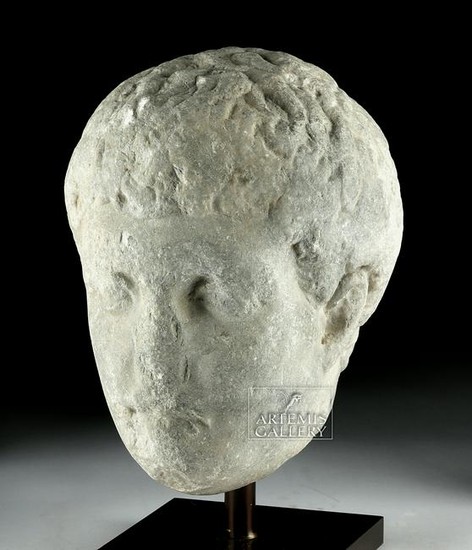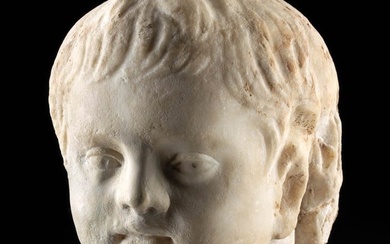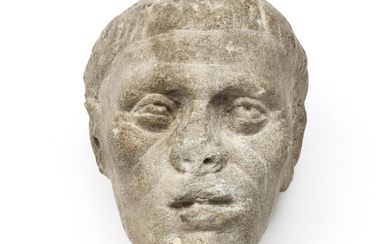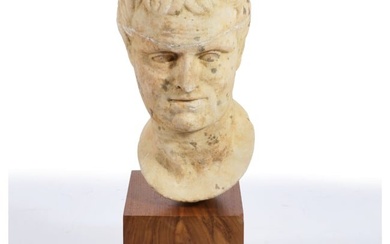Roman Marble Head of a Male Youth
Roman, Imperial Period, Julio-Claudian Period, ca. 1st Century BCE to 1st Century CE. A Roman marble head of a youthful male with idealized features as opposed to the veristic representations popular during the Republican period. Notice that the sculptor presents this individual's visage with clean-shaven skin and handsome features such as deep-set eyes, an aquiline nose (losses as shown), slightly-parted lips, soft facial planes, and closely cropped, wavy hair. The classicizing features and treatment of the eyes suggest that the head was created during the Julio-Claudian Period. Size: 8" W x 11.5" H (20.3 cm x 29.2 cm); 13" H (33 cm) on included custom stand.
It is possible that this youth was actually a portrait of a young regal. Augustan and Julio-Claudian portraits emphasized the beauty and youth of their leaders. Augustus set this precedent which was subscribed to by imperial portraiture until the reign of Constantine the Great. The Romans' idealizations of emperor's images were designed to present visual associations with their predecessors - serving as a means of legitimatizing the emperor's authority. For instance, according to the Metropolitan Museum of Art's Heilbrunn Timeline essay entitled "Roman Portrait Sculpture: The Stylistic Cycle," Tiberius' portraits presented an uncanny resemblance to those of Augustus, even though the two were not related. The author states, "Tiberius (r. 14–37 A.D.) (1994.230.7) was not actually related to Augustus, but his portraits portray a remarkable, and fictionalized, resemblance that connected him to the princeps and helped substantiate his position as successor. Even Tiberius’ successor Caligula (r. 37–41 A.D.) (14.37), who had no interest in continuing Augustus’ administrative ideals and was much more concerned with promoting his own agenda, followed the Augustan and Tiberian portrait tradition of classical and idealized features that carried a strong 'family' resemblance." (https://www.metmuseum.org/toah/hd/ropo2/hd_ropo2.htm)
Provenance: ex-Phoenix Ancient Art, New York, New York, USA, purchased in 2000
All items legal to buy/sell under U.S. Statute covering cultural patrimony Code 2600, CHAPTER 14, and are guaranteed to be as described or your money back.
A Certificate of Authenticity will accompany all winning bids.
We ship worldwide to most countries and handle all shipping in-house for your convenience.
#133834
Condition Report: A section from a larger sculpture with loss to the neck as shown. Normal surface wear with abraded areas, particularly to his high-pointed facial features (nose, browline, lips).
View it on
Estimate
Time, Location
Auction House
Roman, Imperial Period, Julio-Claudian Period, ca. 1st Century BCE to 1st Century CE. A Roman marble head of a youthful male with idealized features as opposed to the veristic representations popular during the Republican period. Notice that the sculptor presents this individual's visage with clean-shaven skin and handsome features such as deep-set eyes, an aquiline nose (losses as shown), slightly-parted lips, soft facial planes, and closely cropped, wavy hair. The classicizing features and treatment of the eyes suggest that the head was created during the Julio-Claudian Period. Size: 8" W x 11.5" H (20.3 cm x 29.2 cm); 13" H (33 cm) on included custom stand.
It is possible that this youth was actually a portrait of a young regal. Augustan and Julio-Claudian portraits emphasized the beauty and youth of their leaders. Augustus set this precedent which was subscribed to by imperial portraiture until the reign of Constantine the Great. The Romans' idealizations of emperor's images were designed to present visual associations with their predecessors - serving as a means of legitimatizing the emperor's authority. For instance, according to the Metropolitan Museum of Art's Heilbrunn Timeline essay entitled "Roman Portrait Sculpture: The Stylistic Cycle," Tiberius' portraits presented an uncanny resemblance to those of Augustus, even though the two were not related. The author states, "Tiberius (r. 14–37 A.D.) (1994.230.7) was not actually related to Augustus, but his portraits portray a remarkable, and fictionalized, resemblance that connected him to the princeps and helped substantiate his position as successor. Even Tiberius’ successor Caligula (r. 37–41 A.D.) (14.37), who had no interest in continuing Augustus’ administrative ideals and was much more concerned with promoting his own agenda, followed the Augustan and Tiberian portrait tradition of classical and idealized features that carried a strong 'family' resemblance." (https://www.metmuseum.org/toah/hd/ropo2/hd_ropo2.htm)
Provenance: ex-Phoenix Ancient Art, New York, New York, USA, purchased in 2000
All items legal to buy/sell under U.S. Statute covering cultural patrimony Code 2600, CHAPTER 14, and are guaranteed to be as described or your money back.
A Certificate of Authenticity will accompany all winning bids.
We ship worldwide to most countries and handle all shipping in-house for your convenience.
#133834
Condition Report: A section from a larger sculpture with loss to the neck as shown. Normal surface wear with abraded areas, particularly to his high-pointed facial features (nose, browline, lips).






